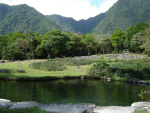The World's Only Village in a Volcano - El Valle

The world’s only town, city or village built within and surrounded by the intact walls of a volcano. I use those three descriptive terms because El Valle is a city with its own police and fire stations. It also serves as a satellite town center for the provincial governments while some might consider it a village since it has only 3,000 full-time residents who actually live inside the caldera of the El Valle Volcano number 1406-03. El Valle is the world’s second largest intact and un-flooded singular volcanic caldera surpassed only by the Ngorongoro crater in Tanzania, Africa. El Valle also has the distinction of being the earth’s oldest continually occupied volcanic site with a history that reaches back at least 10,000 years.
Granted there are many other larger volcanoes in terms of acreage or cubic mass displaced during historical eruptions. Nevertheless, none of these sites, with the exception of Ngorongoro, has a larger single intact, meaning continuous unbroken and un-flooded, caldera. There are many settlements throughout the world built on the sides, at the base of, around the perimeter or over other volcanic eruptions but no other community exists inside or on the valley floor of any singular intact volcanic caldera.
There are other volcanic sites made up of several calderas whose combined acreage far surpasses that of El Valle as well as numerous crater lakes that have a greater surface area but only the Tanzania site has a larger circumference intact caldera. Although you’ll see many volcanic destinations advertised as the world’s largest, tallest, deepest, or highest each one of those claims needs to be qualified and I hope I’ve done that in regard to El Valle’s volcanic fame. Furthermore, there are a few volcanoes with a minimal number of subsistence farmers living in them but none of these communities has any infrastructure like El Valle’s municipal water, electricity, cable, internet, ATM’s and other post modern conveniences.
El Valle’s caldera, which reaches to 2,888 feet at its highest point, was built up over several millennia and the last magma blast probably exploded over 35,000 years when lava flows reached all the way to the Pacific in Coronado. Some Phreatic activity, water and magma eruptions without lava, probably took place around 13,000 years ago but did little to change the configuration of the crater. For thousands of years the El Valle Crater existed as a deep lake until a fissure materialized and the waters drained exposing the compressed lake bed that was to become some of the richest soil in Panama after the original peoples slash and burn agricultural methods sequestered the volcanic deposits with even more carbon. Both the volcano and the village of El Valle de Anton are part of the nineteen square mile Altos de Campana National Park, Panama’s first national preserve created in 1966.
El Valle’s Eden like setting has only recently experienced the global onslaughts of technology and its cool temperatures and quiet beauty have made it a second home locale for Panama’s elite and a weekend day trip for many middle class families who can afford autos. The mode of transportation for most locals is the bicycle and the weekday rush hour looks like a critical mass demonstration in San Francisco as entire families glide over the local streets sometime four to a bike. The major retail hub for the village is Coronado, about 30 miles away, that is experiencing a retail building boom including two strip malls with major grocery stores, a food court, several ubiquitous global fast food chains and a variety of other businesses. These added outlets will certainly provide more jobs for the locals but at the same time change the cultural landscape forever bringing more tourists and expats to the area.
Glenn Gamboa
The Three Sisters
http://elvalleecotour.wordpress.com/
